中国科学技术大学:《程序分析与程序验证》课程教学资源(课件讲稿)第5章 类型和效果系统(Nielson等)Principles of Program Analysis - Type and Effect Systems
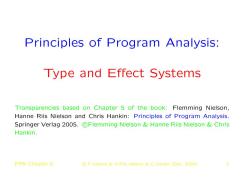
Principles of Program Analysis: Type and Effect Systems Transparencies based on Chapter 5 of the book:Flemming Nielson, Hanne Riis Nielson and Chris Hankin:Principles of Program Analysis. Springer Verlag 2005.CFlemming Nielson Hanne Riis Nielson Chris Hankin. PPA Chapter 5 C F.Nielson H.Riis Nielson C.Hankin (Dec.2004) 1
Principles of Program Analysis: Type and Effect Systems Transparencies based on Chapter 5 of the book: Flemming Nielson, Hanne Riis Nielson and Chris Hankin: Principles of Program Analysis. Springer Verlag 2005. c Flemming Nielson & Hanne Riis Nielson & Chris Hankin. PPA Chapter 5 c F.Nielson & H.Riis Nielson & C.Hankin (Dec. 2004) 1
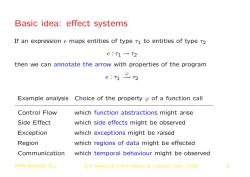
Basic idea:effect systems If an expression e maps entities of type T1 to entities of type 72 e:T1→T2 then we can annotate the arrow with properties of the program e:12 Example analysis Choice of the property of a function call Control Flow which function abstractions might arise Side Effect which side effects might be observed Exception which exceptions might be raised Region which regions of data might be effected Communication which temporal behaviour might be observed PPA Section 5.1 C F.Nielson H.Riis Nielson C.Hankin (Dec.2004) 2
Basic idea: effect systems If an expression e maps entities of type τ1 to entities of type τ2 e : τ1 → τ2 then we can annotate the arrow with properties of the program e : τ1 ϕ → τ2 Example analysis Choice of the property ϕ of a function call Control Flow which function abstractions might arise Side Effect which side effects might be observed Exception which exceptions might be raised Region which regions of data might be effected Communication which temporal behaviour might be observed PPA Section 5.1 c F.Nielson & H.Riis Nielson & C.Hankin (Dec. 2004) 2
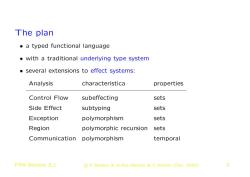
The plan a typed functional language with a traditional underlying type system several extensions to effect systems: Analysis characteristica properties Control Flow subeffecting sets Side Effect subtyping sets Exception polymorphism sets Region polymorphic recursion sets Communication polymorphism temporal PPA Section 5.1 F.Nielson H.Riis Nielson C.Hankin (Dec.2004) 3
The plan • a typed functional language • with a traditional underlying type system • several extensions to effect systems: Analysis characteristica properties Control Flow subeffecting sets Side Effect subtyping sets Exception polymorphism sets Region polymorphic recursion sets Communication polymorphism temporal PPA Section 5.1 c F.Nielson & H.Riis Nielson & C.Hankin (Dec. 2004) 3
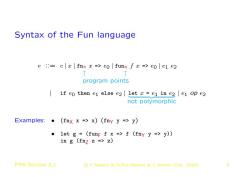
Syntax of the Fun language e:=cxfnπx=>e0funπfx=>e0e1e2 ↑ ↑ program points if eo then e1 else e2 let x e1 in e2 e1 op e2 not polymorphic Examples:·(fnxx=>x)(fnYy=>y) .let g (funF f x =f (fny y =y)) in g (fnz z =z) PPA Section 5.1 C F.Nielson H.Riis Nielson C.Hankin (Dec.2004) 4
Syntax of the Fun language e ::= c | x | fnπ x => e0 | funπ f x => e0 | e1 e2 ↑ ↑ program points | if e0 then e1 else e2 | | let x = {z e1 in e2} not polymorphic | e1 op e2 Examples: • (fnX x => x) (fnY y => y) • let g = (funF f x => f (fnY y => y)) in g (fnZ z => z) PPA Section 5.1 c F.Nielson & H.Riis Nielson & C.Hankin (Dec. 2004) 4
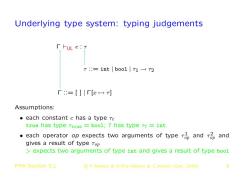
Underlying type system:typing judgements 「-uLe:T T:=int|boo1T1→2 「=[]|「[x→T] Assumptions: each constant c has a type Tc true has type Ttrue =bool;7 has type T7=int each operator op expects two arguments of type Top andp and ● gives a result of type Top expects two arguments of type int and gives a result of type bool PPA Section 5.1 F.Nielson H.Riis Nielson C.Hankin (Dec.2004) 5
Underlying type system: typing judgements Γ `UL e : τ ✻ τ ::= int | bool | τ1 → τ2 ✻ Γ ::= [ ] | Γ[x 7→ τ] Assumptions: • each constant c has a type τc true has type τtrue = bool; 7 has type τ7 = int • each operator op expects two arguments of type τ 1 op and τ 2 op and gives a result of type τop > expects two arguments of type int and gives a result of type bool PPA Section 5.1 c F.Nielson & H.Riis Nielson & C.Hankin (Dec. 2004) 5
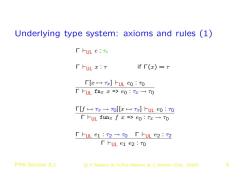
Underlying type system:axioms and rules (1) 「FULC:Tc 「上ULx:T if「(x)=T r[x→Tx]FUL eo:To 「FUL fnr 2=>e0:Tx→T0 「[f→Tx→To][x→Tx]上ULeo:To 「FUL funr f x=>eo:Tx→To 「卜ULe1:T2→T0「FULe2:T2 「-uLe1e2:To PPA Section 5.1 C F.Nielson H.Riis Nielson C.Hankin (Dec.2004) 6
Underlying type system: axioms and rules (1) Γ `UL c : τc Γ `UL x : τ if Γ(x) = τ Γ[x 7→ τx] `UL e0 : τ0 Γ `UL fnπ x => e0 : τx → τ0 Γ[f 7→ τx → τ0][x 7→ τx] `UL e0 : τ0 Γ `UL funπ f x => e0 : τx → τ0 Γ `UL e1 : τ2 → τ0 Γ `UL e2 : τ2 Γ `UL e1 e2 : τ0 PPA Section 5.1 c F.Nielson & H.Riis Nielson & C.Hankin (Dec. 2004) 6
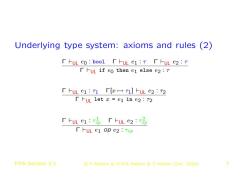
Underlying type system:axioms and rules (2) 「rULe0:boo1「FULe1:T「-ULe2:T FUL if eo then e1 else e2:T 厂上ULe1:T1「[x→T1]HULe2:T2 「FUL let x=e1ine2:T2 「huLe1:T品「FuLe2:T 「r-ULe1ope2:Top PPA Section 5.1 C F.Nielson H.Riis Nielson C.Hankin (Dec.2004) 7
Underlying type system: axioms and rules (2) Γ `UL e0 : bool Γ `UL e1 : τ Γ `UL e2 : τ Γ `UL if e0 then e1 else e2 : τ Γ `UL e1 : τ1 Γ[x 7→ τ1] `UL e2 : τ2 Γ `UL let x = e1 in e2 : τ2 Γ `UL e1 : τ 1 op Γ `UL e2 : τ 2 op Γ `UL e1 op e2 : τop PPA Section 5.1 c F.Nielson & H.Riis Nielson & C.Hankin (Dec. 2004) 7
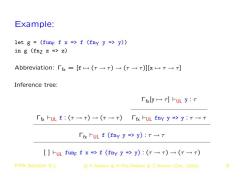
Example: let g=(funF f x =f (fny y =y)) in g (fn7 z =z) Abbreviation:「fx=[f一(r→T)→(T→T)][x一T→T] Inference tree: 「fx[y一T]FULy:T 「x FUL f:(T→T)一(T→T)「x上UL fny y=>y:T一T 「fx卜ULf(fnyy=>y):T一T []HUL funF f x=>f(fnYy=>y):(T→T)→(r一T) PPA Section 5.1 C F.Nielson H.Riis Nielson C.Hankin (Dec.2004) 8
Example: let g = (funF f x => f (fnY y => y)) in g (fnZ z => z) Abbreviation: Γfx = [f 7→ (τ → τ) → (τ → τ)][x 7→ τ → τ] Inference tree: Γfx[y 7→ τ] `UL y : τ Γfx `UL f : (τ → τ) → (τ → τ) Γfx `UL fnY y => y : τ → τ Γfx `UL f (fnY y => y) : τ → τ [ ] `UL funF f x => f (fnY y => y) : (τ → τ) → (τ → τ) PPA Section 5.1 c F.Nielson & H.Riis Nielson & C.Hankin (Dec. 2004) 8
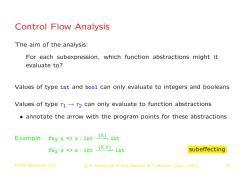
Control Flow Analysis The aim of the analysis: For each subexpression,which function abstractions might it evaluate to? Values of type int and bool can only evaluate to integers and booleans Values of type T1-72 can only evaluate to function abstractions annotate the arrow with the program points for these abstractions Example:fnx x =>x int (XL int fny x =x:int xY int subeffecting PPA Section 5.1 F.Nielson H.Riis Nielson C.Hankin (Dec.2004) 9
Control Flow Analysis The aim of the analysis: For each subexpression, which function abstractions might it evaluate to? Values of type int and bool can only evaluate to integers and booleans Values of type τ1 → τ2 can only evaluate to function abstractions • annotate the arrow with the program points for these abstractions Example: fnX x => x : int {X →} int fnX x => x : int {X,Y →} int subeffecting PPA Section 5.1 c F.Nielson & H.Riis Nielson & C.Hankin (Dec. 2004) 9
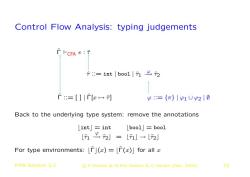
Control Flow Analysis:typing judgements HCFA e 子:=int|bool|122 广:=[]|[x→] p:={π}|p1Up2|0 Back to the underlying type system:remove the annotations Lint」=int bool]=bool L方12=L」→L2 For type environments:[](x)=(x)]for all x PPA Section 5.1 C F.Nielson H.Riis Nielson C.Hankin (Dec.2004) 10
Control Flow Analysis: typing judgements Γb `CFA e : τb ✻ τb ::= int | bool | τb1 →ϕ τb2 ✻ ϕ ::= {π} | ϕ1 ∪ ϕ2 | ∅ ✻ Γ ::= [ ] b | Γ[ b x 7→ τb] Back to the underlying type system: remove the annotations bintc = int bboolc = bool bτb1 ϕ → τb2c = bτb1c → bτb2c For type environments: bΓbc(x) = bΓ(b x)c for all x PPA Section 5.1 c F.Nielson & H.Riis Nielson & C.Hankin (Dec. 2004) 10
按次数下载不扣除下载券;
注册用户24小时内重复下载只扣除一次;
顺序:VIP每日次数-->可用次数-->下载券;
- 中国科学技术大学:《程序分析与程序验证》课程教学资源(PPT课件讲稿)第4章 抽象解释(补充).ppt
- 中国科学技术大学:《程序分析与程序验证》课程教学资源(课件讲稿)第4章 抽象解释(Nielson等)Principles of Program Analysis - Abstract Interpretation.pdf
- 中国科学技术大学:《程序分析与程序验证》课程教学资源(PPT课件讲稿)第3章 基于约束的分析(补充).ppt
- 中国科学技术大学:《程序分析与程序验证》课程教学资源(课件讲稿)第3章 基于约束的分析(Nielson等)Principles of Program Analysis - Control Flow Analysis.pdf
- 中国科学技术大学:《程序分析与程序验证》课程教学资源(PPT课件讲稿)第2章 数据流分析(补充).ppt
- 中国科学技术大学:《程序分析与程序验证》课程教学资源(课件讲稿)第2章 数据流分析(Nielson等)Principles of Program Analysis - Data Flow Analysis.pdf
- 中国科学技术大学:《程序分析与程序验证》课程教学资源(PPT课件讲稿)第1章 引言(主讲:陈意云).ppt
- 中国科学技术大学:《编译原理与技术》课程教学资源(PPT课件讲稿)第9章 独立于机器的优化.ppt
- 中国科学技术大学:《编译原理与技术》课程教学资源(PPT课件讲稿)第8章 代码生成.ppt
- 中国科学技术大学:《编译原理与技术》课程教学资源(PPT课件讲稿)第7章 中间代码生成.ppt
- 中国科学技术大学:《编译原理与技术》课程教学资源(PPT课件讲稿)第13章 函数式语言的编译.ppt
- 中国科学技术大学:《编译原理与技术》课程教学资源(PPT课件讲稿)第12章 面向对象语言的编译.ppt
- 中国科学技术大学:《编译原理与技术》课程教学资源(PPT课件讲稿)第11章 编译系统和运行系统.ppt
- 中国科学技术大学:《编译原理与技术》课程教学资源(PPT课件讲稿)第10章 依赖于机器的优化.ppt
- 中国科学技术大学:《编译原理与技术》课程教学资源(PPT课件讲稿)第6章 运行时存储空间的组织和管理.ppt
- 中国科学技术大学:《编译原理与技术》课程教学资源(PPT课件讲稿)第5章 类型检查.ppt
- 中国科学技术大学:《编译原理与技术》课程教学资源(PPT课件讲稿)第4章 语法制导的翻译.ppt
- 中国科学技术大学:《编译原理与技术》课程教学资源(PPT课件讲稿)第3章 语法分析.ppt
- 中国科学技术大学:《编译原理与技术》课程教学资源(PPT课件讲稿)第2章 词法分析.ppt
- 中国科学技术大学:《编译原理与技术》课程教学资源(PPT课件讲稿)第1章 引论(主讲:张昱、陈意云).ppt
- 中国科学技术大学:《程序分析与程序验证》课程教学资源(PPT课件讲稿)第5章 类型和效果系统(补充).ppt
- 中国科学技术大学:《程序分析与程序验证》课程教学资源(PPT课件讲稿)第6章 模型检测.ppt
- 中国科学技术大学:《程序分析与程序验证》课程教学资源(PPT课件讲稿)第7章 程序验证 Program verification.ppt
- 中国科学技术大学:《程序分析与程序验证》课程教学资源(PPT课件讲稿)第7章 程序验证 ProgramVerification Necula 01 Theorem Proving.ppt
- 中国科学技术大学:《程序分析与程序验证》课程教学资源(PPT课件讲稿)第7章 程序验证 ProgramVerification Necula 02 Finish Verification Condition Generation Simple Prover for FOL.ppt
- 中国科学技术大学:《程序分析与程序验证》课程教学资源(PPT课件讲稿)第7章 程序验证 ProgramVerification Necula 03 Theorem Proving for FOL Satisfiability Procedures.ppt
- 中国科学技术大学:《程序分析与程序验证》课程教学资源(PPT课件讲稿)第7章 程序验证 ProgramVerification Necula 04 Decision-Procedure Based Theorem Provers Tactic-Based Theorem Proving Inferring Loop Invariants.ppt
- 中国科学技术大学:《程序设计语言理论》课程教学资源(参考教材)第1章 引言.pdf
- 中国科学技术大学:《程序设计语言理论》课程教学资源(参考教材)第2章 泛代数和代数数据类型.pdf
- 中国科学技术大学:《程序设计语言理论》课程教学资源(参考教材)第6章 递归类型.pdf
- 中国科学技术大学:《程序设计语言理论》课程教学资源(PPT课件讲稿)第1章 引言(主讲:陈意云).ppt
- 中国科学技术大学:《程序设计语言理论》课程教学资源(PPT课件讲稿)第2章 泛代数和代数数据类型.ppt
- 中国科学技术大学:《程序设计语言理论》课程教学资源(PPT课件讲稿)第3章 简单类型化λ演算.ppt
- 中国科学技术大学:《程序设计语言理论》课程教学资源(PPT课件讲稿)第4章 类型化λ演算的模型.ppt
- 中国科学技术大学:《程序设计语言理论》课程教学资源(PPT课件讲稿)第5章 命令式程序的语义.ppt
- 中国科学技术大学:《程序设计语言理论》课程教学资源(PPT课件讲稿)第6章 递归类型.ppt
- 中国科学技术大学:《程序设计语言理论》课程教学资源(PPT课件讲稿)第7章 多态性.ppt
- 中国科学技术大学:《程序设计语言理论》课程教学资源(PPT课件讲稿)第8章 依赖类型.ppt
- 中国科学技术大学:《程序设计语言理论》课程教学资源(PPT课件讲稿)第9章 类型推断.ppt
- 中国科学技术大学:《程序设计语言理论》课程教学资源(PPT课件讲稿)第10章 子定型.ppt
